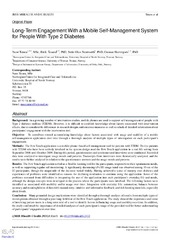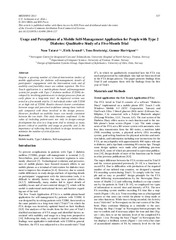| dc.contributor.advisor | Hartvigsen, Gunnar | |
| dc.contributor.author | Tatara, Naoe | |
| dc.date.accessioned | 2014-03-28T09:38:20Z | |
| dc.date.available | 2014-03-28T09:38:20Z | |
| dc.date.issued | 2014-02-28 | |
| dc.description.abstract | In spite of a number of mHealth (use of mobile computing for health care) studies targeting people with diabetes, there has not yet been any clear evidence of its effect. Due to obscurity regarding subjects’ engagement with each component of the provided technology, it is not clear which factors are important and why. Considering that behavior change is a path of improvement in self-management of Type 2 diabetes mellitus (T2DM), it is crucial to investigate users’ usage and experiences of mHealth technology over time. Furthermore, ensuring usability of a technology is essential for the initial uptake and continuous usage of it.
This research was conducted in three phases using mixed methods research. In Phases 1 and 2, long-term trials of a mobile phone-based self-help application “the Few Touch application” were carried out by involving two different user groups: one had been involved in the design process from an early stage and the other had not. In Phase 3, design of a food-information database module as a part of improvement of the Few Touch application was carried out by involving users and non-users.
The study empirically showed the following: the users basically used and experienced the Few Touch application as a flexible learning tool in terms of self-management of T2DM. Patterns and degrees of usage varied a lot among users and they changed over time depending on each user’s needs and background both directly and indirectly relevant to T2DM. This was because motivation for continuation of usage was a result of balancing between expected benefit and effort required to use it. Usability of the technology could be improved by designing it so that it simplifies tedious self-management activities without posing extra effort to use the technology while it enhances the learning process and maximizes its learning effect. | en |
| dc.description.doctoraltype | ph.d. | en |
| dc.description.popularabstract | Studien er utført med mixed methods research for å undersøke bruk og opplevelse av et mobiltelefonbasert selvhjelpsverktøy for mennesker med type 2-diabetes (T2DM), “the Few Touch application”. Langsiktig testing av applikasjonen ble utført ved å involvere to ulike brukergrupper. Som en del av applikasjonen ble en matvare-database utformet. Dette ble utført ved å involvere både brukere og ikke-brukere. Studien viste empirisk følgende: brukerne brukte og opplevde applikasjonen som et fleksibelt verktøy for å lære om sin T2DM. Mønster og grad av bruk varierte svært mye blant brukerne og endret seg også over tid. Disse variasjonene og endringene var avhengig av hver enkelt brukers behov og bakgrunn. Brukervennligheten av teknologien kunne forbedres ved å utforme den slik at den forenkler kjedelige egenmestringsaktiviteter uten at dette medfører ekstra innsats, men likevel slik at den forbedrer læringsprosessen og maksimerer læringseffekten. | en |
| dc.description.sponsorship | Tromsø Telemedicine Laboratory (TTL) funded by the Norwegian Research Council Grant No. 174934 | en |
| dc.description | Paper 1, 4 and 5 of this thesis are not available in Munin: <br/>1. Årsand E, Nilsen H, Hartvigsen G.: 'A Review of Mobile Terminal-Based
Applications for Self-Management of Patients with Diabetes', Proceedings of International
Conference on eHealth, Telemedicine, and Social Medicine (2009), pages 166-175. Available at <a href=http://dx.doi.org/10.1109/eTELEMED.2009.14>http://dx.doi.org/10.1109/eTELEMED.2009.14</a> <br/>4. Tatara N, Årsand E, Hartvigsen G.: 'Patient-user involvement for designing a self-help tool for Type 2 diabetes', in Proceedings of Therapeutic Strategies A Challenge for User Involvement in Design: Workshop in conjunction with NordiCHI2010 (2010), pages 53-55. <br/>5. Tatara N, Bratteteig T.: 'Making it Easy is not so Easy: Interaction Design with Text and Image on a Small Screen' (manuscript). | en |
| dc.identifier.isbn | 978-82-8236-123-1 (pdf) | |
| dc.identifier.uri | https://hdl.handle.net/10037/6107 | |
| dc.identifier.urn | URN:NBN:no-uit_munin_5796 | |
| dc.language.iso | eng | en |
| dc.publisher | UiT Norges arktiske universitet | en |
| dc.publisher | UiT The Arctic University of Norway | en |
| dc.rights.accessRights | openAccess | |
| dc.rights.holder | Copyright 2014 The Author(s) | |
| dc.rights.uri | https://creativecommons.org/licenses/by-nc-sa/3.0 | en_US |
| dc.rights | Attribution-NonCommercial-ShareAlike 3.0 Unported (CC BY-NC-SA 3.0) | en_US |
| dc.subject | VDP::Mathematics and natural science: 400::Information and communication science: 420::System development and system design: 426 | en |
| dc.subject | VDP::Matematikk og Naturvitenskap: 400::Informasjons- og kommunikasjonsvitenskap: 420::Systemutvikling og -arbeid: 426 | en |
| dc.subject | Human Computer Interaction | en |
| dc.subject | Human Computer Interaction | en |
| dc.subject | Mobile phone application | en |
| dc.subject | Mobiltelefonbasert applikasjon | en |
| dc.subject | Type 2 diabetes mellitus | en |
| dc.subject | Type 2-diabetes | en |
| dc.subject | Usability | en |
| dc.subject | Brukervennlighet | en |
| dc.subject | Mixed methods research | en |
| dc.subject | Mixed methods research | en |
| dc.title | Studying usage and experiences of mHealth technology for its improved usability
- Mixed methods research for understanding users’ long-term engagement with the Few Touch application for self-management of Type 2 diabetes mellitus - | en |
| dc.type | Doctoral thesis | en |
| dc.type | Doktorgradsavhandling | en |


 English
English norsk
norsk


